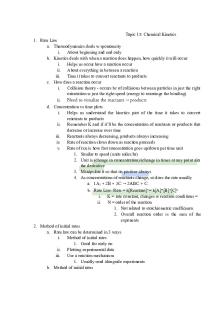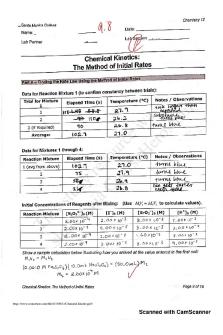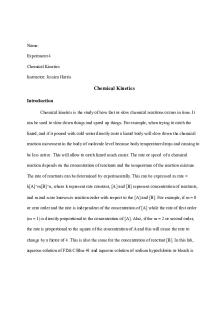Chapter 14- Chemical Kinetics PDF

| Title | Chapter 14- Chemical Kinetics |
|---|---|
| Course | Chem II Lecture |
| Institution | East Stroudsburg University |
| Pages | 3 |
| File Size | 92 KB |
| File Type | |
| Total Downloads | 38 |
| Total Views | 169 |
Summary
Dr, Gold chapter 14 lecture notes...
Description
Chapter 14- Chemical Kinetics Chem 124 Lecture Notes 14.1 Rates of Reactions
List and describe the factors that affect reaction rates Express reactions rates in relation to reaction stoichiometry
Changing Reaction Rates
The rate of a chemical reaction, or reaction rate, is defied as the change in the concentration of a reactant or product per unit time. Measured as the disappearance of a reactant over time or the appearance of a product over time Units reflect how fast or slowly the reaction occurs o M/h for faster reactions o mM/h or (mu)M/h for slower reactions o can also change to the time to minutes or seconds five factors that affect reaction rates o the particle size of solid reactants (surface area) influences how well the reactants come in contact with each other o the concentration of reactants influences how often reactant particles collide o the temperature influences the kinetic energy with which reactant particles collide o the nature (potential energy) of the reactants o the presence of a catalyst influences the energy needed to initiate reaction
Measuring Reaction Rates
Reaction rates are measured by monitoring the change on concentration of a reactant or product over time, t. The rate of the generic reaction A B can be expressed as the rate at which A decreases or as the rate at which B increases Rate units are typically molar per second, M/s Slower reactions may be expressed as M/min or M/hr
Stoichiometry and Reaction Rates
For a reaction such as A B, there is a 1:1 relationship between the disappearance of A and the appearance of B However, if the reaction is 2A B, then A disappears at twice the rate that B appears Many reactions involve more than one reactant or product, such as the reaction, A B+ 2 C You can follow the progress of the reaction by monitoring the concentration of A, B, or C For the reaction, aA bB, where a and b are stoichiometric coefficients in the balanced chemical equation.
Measuring Concentrations
Many substances absorb electromagnetic radiation, which can be measured in a lab Colorful substances absorb visible light, and many seemingly colorless substances do absorb light in the ultraviolet range
Chapter 14- Chemical Kinetics Chem 124 Lecture Notes
As the concentration of a substance increases, more electromagnetic radiation is absorbed, making it possible to monitor changes in concentration in real time.
Section Review
Reaction rates are affected by five factors All chemical reactions require energy to initiate the reaction Increasing the temperature increases the rates of all chemical reactions Increasing the concentration of reactants increases the reaction rate Catalysts provide a lower energy pathway for the reaction Reaction rates can be measured by the disappearance of a reactance or the appearance of a product. For the reaction, aA bB, where a and b are stoichiometric coefficients in a balanced chemical equation The concentrations of reactions of reactants and/or products in many reactions can be measured spectroscopically, because many compounds absorb electromagnetic radiation
14.2 Reaction Rates and Concentration: Rate Laws
Use experimental data to write rate laws for chemical reactions
Measuring Reaction Rates
Reaction rates can be measured as average rates or as instantaneous rates. For an average rate, the concentration is measured at two times and the change in concentration is divided by the change in time Instantaneous rates are measured by plotting concentration vs. time and determining the slope of a tangent to that plot Instantaneous rates differ greatly as the overall rate of the reaction slows
Initial Rates
Chemists often determine instantaneous rates as close as possible to the start of the reaction (time zero): these are initial rates This is important because the rate of reaction slows over time as the reactant concentration decreases
Reaction Rates and Rate Laws
The mathematical description for the dependence of a reaction rate upon the concentration of its reactants is called a rate law Rate laws include a proportionality constant called a rate constant, k, which is determined experimentally, and a term for the concentration of each reactant raised to the power of its order, n, also determined experimentally
Reaction Order, n
Common values of n are 0,1, and 2, although negative and fractional values are possible o When n=0, the reaction is zero order with respect to A o When n=1, the reaction is first order with respect to A o When n=2, the reaction is second order with respect to- A When a reaction has multiple reactants, each reactant has its ow order, and the overall reaction order is the sum of the orders with respect to each reactant
Chapter 14- Chemical Kinetics Chem 124 Lecture Notes Rate Law: aA+Bb products
Determine the values of k, n, and m experimentally If n reactant and m are both equal to 1, then the reaction is first order with respect to each reactant and second order overall
Rate and Order of Reactions
In zero-order reactions, changing the concentration of the reactant has no effect on the rate of the reaction In first-order reactions, n-1, the rate law is simply, rate= kA o If A is doubled, the reaction rate also doubles o When A drops to one-half of the initial concentration, the reaction rate is one-half the initial rate. In a second-order reaction with a single reactant. o n= 2 and o rate= k[A]2 When the concentration of A is doubled, the rate of the reaction increases by a factor of 22=4. Thus, the rate is quadrupled When A drops to one-half of its initial concentration, the reaction rate is one-fourth of its initial rate.
Determining Reaction Order aA Products
Measure the reaction’s initial rate at different concentrations of the reactant, keeping all other conditions uncharged Compare the changes in rate to the changes in concentration to determine n...
Similar Free PDFs

Chapter 14- Chemical Kinetics
- 3 Pages

Chapter 14 - Kinetics
- 6 Pages

Ch. 14 Chemical Kinetics Study Guide
- 11 Pages

Topic 15 Chemical Kinetics
- 5 Pages

Chemical Kinetics lab
- 9 Pages

Chemical Kinetics-DR. ASM
- 44 Pages

Chemical Kinetics - lab report
- 4 Pages

Lab 11 Chemical Kinetics Report
- 4 Pages

Chemical Kinetics - Lecture notes 1
- 23 Pages
Popular Institutions
- Tinajero National High School - Annex
- Politeknik Caltex Riau
- Yokohama City University
- SGT University
- University of Al-Qadisiyah
- Divine Word College of Vigan
- Techniek College Rotterdam
- Universidade de Santiago
- Universiti Teknologi MARA Cawangan Johor Kampus Pasir Gudang
- Poltekkes Kemenkes Yogyakarta
- Baguio City National High School
- Colegio san marcos
- preparatoria uno
- Centro de Bachillerato Tecnológico Industrial y de Servicios No. 107
- Dalian Maritime University
- Quang Trung Secondary School
- Colegio Tecnológico en Informática
- Corporación Regional de Educación Superior
- Grupo CEDVA
- Dar Al Uloom University
- Centro de Estudios Preuniversitarios de la Universidad Nacional de Ingeniería
- 上智大学
- Aakash International School, Nuna Majara
- San Felipe Neri Catholic School
- Kang Chiao International School - New Taipei City
- Misamis Occidental National High School
- Institución Educativa Escuela Normal Juan Ladrilleros
- Kolehiyo ng Pantukan
- Batanes State College
- Instituto Continental
- Sekolah Menengah Kejuruan Kesehatan Kaltara (Tarakan)
- Colegio de La Inmaculada Concepcion - Cebu






